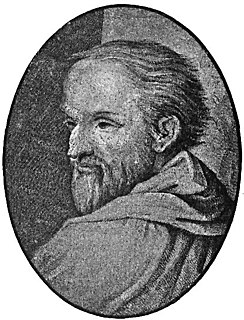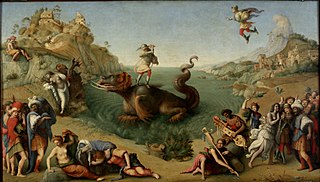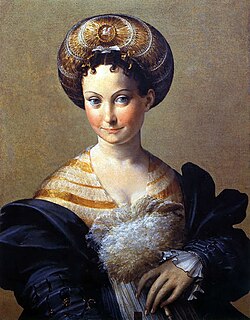
The Uffizi Gallery is a prominent art museum located adjacent to the Piazza della Signoria in the Historic Centre of Florence in the region of Tuscany, Italy. One of the most important Italian museums and the most visited, it is also one of the largest and best known in the world and holds a collection of priceless works, particularly from the period of the Italian Renaissance.

Alessandro di Mariano di Vanni Filipepi, known as Sandro Botticelli, was an Italian painter of the Early Renaissance. Botticelli's posthumous reputation suffered until the late 19th century, when he was rediscovered by the Pre-Raphaelites who stimulated a reappraisal of his work. Since then, his paintings have been seen to represent the linear grace of Early Renaissance painting.

Antonio Allegri da Correggio, usually known as just Correggio, was the foremost painter of the Parma school of the High Italian Renaissance, who was responsible for some of the most vigorous and sensuous works of the 16th century. In his use of dynamic composition, illusionistic perspective and dramatic foreshortening, Correggio prefigured the Baroque art of the 17th century and the Rococo art of the 18th century. He is considered a master of chiaroscuro.

Giorgione was an Italian painter of the Venetian school during the High Renaissance from Venice, who died in his thirties. Giorgione is known for the elusive poetic quality of his work, though only about six surviving paintings are firmly attributed to him. The uncertainty surrounding the identity and meaning of his work has made Giorgione one of the most mysterious figures in European art.

Piero di Cosimo, also known as Piero di Lorenzo, was an Italian painter of the Renaissance.

Girolamo Francesco Maria Mazzola, also known as Francesco Mazzola or, more commonly, as Parmigianino, was an Italian Mannerist painter and printmaker active in Florence, Rome, Bologna, and his native city of Parma. His work is characterized by a "refined sensuality" and often elongation of forms and includes Vision of Saint Jerome (1527) and the iconic if somewhat untypical Madonna with the Long Neck (1534), and he remains the best known artist of the first generation whose whole careers fall into the Mannerist period.

Portrait of Simonetta Vespucci is an oil on canvas painting by the Italian Renaissance painter Piero di Cosimo, dating from about 1480 or 1490. It is in the Musée Condé in Chantilly, France.

The Portrait of Smeralda Brandini is a tempera on panel painting by the Italian Renaissance artist Sandro Botticelli of about 1475, in the Victoria and Albert Museum, London.

The Portrait of Perugino is a portrait of the Italian Renaissance artist Perugino attributed to his pupil Raphael or to Lorenzo di Credi. It was produced around 1504 and is now in the Uffizi gallery, Florence.

Andrea del Sarto was an Italian painter from Florence, whose career flourished during the High Renaissance and early Mannerism. He was known as an outstanding fresco decorator, painter of altar-pieces, portraitist, draughtsman and colorist. Though highly regarded during his lifetime as an artist senza errori, his renown was eclipsed after his death by that of his contemporaries, Leonardo da Vinci, Michelangelo and Raphael.

The Lucan portrait of Leonardo da Vinci is a late 15th- or early 16th-century portrait of a man that was discovered in 2008 in a cupboard of a private house in Italy. It strongly resembles a portrait of Leonardo da Vinci by Cristofano dell'Altissimo held by the Uffizi Gallery. The painting was previously thought by its owners to represent Galileo but on its discovery a claim was made that it is a self-portrait by Leonardo da Vinci. Alessandro Vezzosi, director of the Museo Ideale Leonardo da Vinci at Vinci said in 2011 that he had excluded the possibility that it was a self-portrait, but that the painting "remains intriguing because it adds a new element to the Leonardo puzzle".

Portrait of Lorenzo Cybo (1524) is a painting by the Italian late Renaissance artist Parmigianino. It is housed in the Statens Museum for Kunst, Copenhagen, Denmark.

Portrait of a Collector is a painting by the Italian Mannerist artist Parmigianino, executed around 1524.

Self-portrait in a Convex Mirror is a painting by the Italian late Renaissance artist Parmigianino. It is housed in the Kunsthistorisches Museum, Vienna, Austria.

Turkish Slave is a painting by the Italian Mannerist artist Parmigianino, executed around 1533. It is housed in the Galleria nazionale di Parma, northern Italy.

Portrait of Pier Maria Rossi di San Secondo is a painting by the Italian Mannerist artist Parmigianino, executed around 1535–1539 and housed in the Museo del Prado, Madrid, Spain. The subject was Count of San Secondo, and the painting forms a pair with a group portrait of his Countess and their children, Portrait of Camilla Gonzaga and Her Three Sons, although the latter is not unanimously attributed to Parmigianino.

Holy Family with the Infant Saint John the Baptist is a painting by Parmigianino, executed c. 1528. It was in the Palazzo Farnese in Rome until 1662, when it moved to Parma. There it hung in the Palazzo del Giardino and later in the Galleria Ducale - the 'Descrizione' of the latter in 1725 called it one of the finest works on display there. It and the rest of the Farnese collection were later moved to Naples and the work was exhibited for a few years in the Palazzo Reale before moving to its present home in the National Museum of Capodimonte. Two early copies remain in the Galleria Nazionale and Palazzo Comunale in Parma.

Portrait of a Man in a Red Beret or Self-Portrait in a Red Beret is a oil on paper painting attributed to Parmigianino or Michelangelo Anselmi, executed c. 1540, now in the collection of the National Gallery of Parma.

Lucretia is a 1540 oil on panel painting of Lucretia by Parmigianino, originally in the Farnese collection and now in the Museo nazionale di Capodimonte in Naples.

Madonna and Child with Saint Zechariah is a c.1530-1533 oil on panel painting by Parmigianino, now in the Uffizi. It shows the Madonna and Child with Zechariah, father of John the Baptist.



















